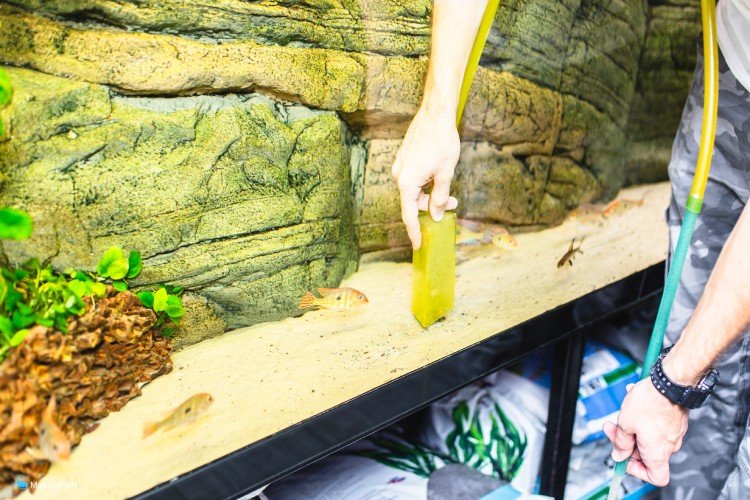Sand makes a great aquarium substrate. It really creates a great aesthetic, there’s not anything that looks more natural in a tank, in my opinion.
But, because grains of sand are so much lighter than pieces of gravel, it’s much more difficult to clean a sand substrate than a gravel one. If you try to vacuum sand the same way you do gravel, you’ll end up losing more than half your substrate and creating a giant mess.
So, here are some tried and true tips on how to clean aquarium sand. I have used both of these methods to clean my home aquariums for years and years.
Table of Contents
1. How To Clean The Surface of Sand Substrate

Equipment:
- Gravel vacuum
- Bucket
- Large spoon or other tool to stir the sand
Step-by-step guide:
- Get your siphon running, make sure the lift tub for the gravel vacuum is above the sand. You may want to kink the drain hose to help slow down the suction.
- Begin to wave the lift tube back and forth about an inch above the surface of the sand. You’re trying to stir up fish poop and other gunk that’s sitting on top of the sand so you can suck it up with the gravel vacuum.
- Make several passes over the sand until you can’t see any more patches of fish poop.
- Prop or clamp the gravel vacuum so it can continue to drain without sucking up any sand.
- Stir up the sand bed, especially any deep areas. You can use your hand or a clean kitchen spoon to reach as much of the bottom as possible.
- You can pass the gravel vacuum back over the surface of the sand if debris gets kicked up.
- Keep working at it until about 50% of the water is drained from the tank.
- Fill the tank back up like you normally would. Don’t forget the water conditioner!
This method will work better for a wider variety of tanks. It takes more time, and a bit more effort, as far as I’m concerned, but it works for most sand bottom tanks and there is less finesse involved.
Because the grains of sand are so much more densely packed together then pieces of gravel, fish poop and uneaten food tend to collect on the surface of the sand, instead of sinking down into the substrate.
This means that you can clean most of the wastes off the top of the sand without needing to push the vacuum down to the point that it sucks up any sand.
However, once you suck up the wastes, you will need to go back and stir the sandbed up.
In a deep sand bed, lack of gas exchange can lead to dead areas that become anaerobic. Small pockets of trapped wastes can start to decompose in these areas, and as they do so, put off poisonous hydrogen sulfide (H2S) gas.
These pockets of gas can accumulate and form large bubbles, which will eventually rupture, sending the hydrogen sulfide into the water column.
Stirring the sand bed regularly will mix in oxygen and prevent anaerobic pockets from forming.
I recommend stirring up the sand bed after you vacuum out wastes.
2. How To Fully Vacuum the Sand
Equipment:
- Gravel vacuum – preferably with a long lift tube and a long drain hose
- Buckets if needed
Step-by-step guide:
- Start your siphon with the lift tube well above the surface of the sand.
- Kink the drain hose so that you can easily and quickly cut down the flow.
- Sink the lift tube down into the sand and quickly pull it back up, then move to the next little patch. Repeat this until you have vacuumed all of the open areas in the aquarium.
- Prop or clamp the gravel vac above the surface of the sand so that it can drain the tank down to 50%.
- Refill the tank as you normally would and make sure to condition your water.
This method really only works for larger tanks. I really wouldn’t even try this method with anything under 30 gallons (113 liters),
Actually vacuuming the sand is a little bit trickier, but I think it gets everything a whole lot cleaner with less effort.
But, not every gravel vacuum will work with this. I highly recommend using as tall a lift tube on the gravel vac as possible. Sand is going to rise up, but the longer lift tube gives you a lot more room for error.
I like a lift tube that is only 6 inches (15 centimeters) shorter than the tank is deep.
You will need to restrict the water flow at times in order to let sand dump back out of the tube. I kink the drain hose about six inches away from the lift tube. I go back and forth crimping and releasing the hose to keep the sand from getting sucked up.
I get the best results using this technique with a gravel vac that has a really long drain hose. I personally use an 18 inch (46 centimeter) lift tube and 12 foot (4 meter) drain hose. I run the drain hose out the door and into the garden.
You could also use a Python style water changing system because you can really control the flow.

Last update on 2024-04-25 / Commissions Earned / Images from Amazon Product Advertising API
Conclusions
It does take a bit more finesse to clean aquarium sand vs. just regular gravel, but it’s pretty simple once you’ve got it figured out.
The biggest thing is to get a feel for kinking the hose so you can control the flow and dump sand out of the lift tube.
I hope you find this article helpful.
I wish you and your fish the very best!
